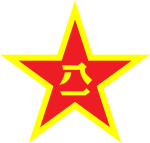77th Group Army
| People's Liberation Army Ground Force 77th Group Army | |||||
|---|---|---|---|---|---|
 | |||||
| Active | 2017 - onwards (13th Gp Army 1985-2017) | ||||
| Country | |||||
| Allegiance | |||||
| Branch | |||||
| Type | Field army | ||||
| Part of | Western Theater Command Ground Force | ||||
| Garrison/HQ | Chongqing | ||||
| March | Military Anthem of the People's Liberation Army | ||||
| Engagements | Long March Second Sino-Japanese War Chinese Civil War Korean War Sino-Indian War Sino-Vietnamese War | ||||
| Commanders | |||||
| Current commander | Major General Lin Huomao, Li Zehua | ||||
| Notable commanders | Chen Geng Xie Fuzhi Zhou Xihan Liu Youguang Lin Biao | ||||
| Insignia | |||||
| NATO Map Symbol |
| ||||
The 77th Group Army is a military formation of the People's Liberation Army Ground Force. It was established in 2017 by seemingly a redesignation of the former 13th Group Army.
The 13th Group Army (Military Unit Cover Designator (MUCD) 56005)[1] was established in 1985 after the disbandment of the 50th Army. It incorporated the 149th Division, which had been part of the 50th Army.[2]
During the Sino-Vietnamese War, the Kunming Military Region took responsibility for Chinese operations during the Battle of Lào Cai, which involved the 11th and 13th Armies from the Kunming Military Region itself, and the 14th Army from the Chengdu Military Region, totalling about 125,000 troops.[3] The three armies was followed by the reserve 149th Division of the 50th Army, as well as many support units.[4] The invasion comprised three prongs of advances: while the 11th Army was assigned to attack Phong Thổ before hooking up to Sa Pa and Lào Cai from the west, the 14th Army was ordered to take Mường Khương and move against Lào Cai from the east; the central thrust was undertaken by the 13th Army, targeting Lào Cai itself, as well as the township of Cam Đường to the south.[5]
Blasko 2002, drawing upon the Directory of PRC Military Personalities, 1999 and 2000 editions, wrote that the 13 GA (MUCD 56005), at Chongqing, comprised the (MUCD 56013), the 149th Motorized Infantry Division (MUCD 56016) at Emei, Sichuan, an Armoured Brigade (MUCD 56017) at Pengzhou, Sichuan, an Artillery Brigade (MUCD 56014) at Chongqing, and an Anti-Aircraft Artillery Brigade (MUCD 56018) at Mianyang, Sichuan.[6]
Since 2002, various sources have identified the armoured brigade as the and also added 2nd Helicopter Regiment and a Special Operations Group to the listing.
Officers[]
Commanders[]
- Zhou Xihan: 1949–1952
- Chen Kang: 1952–1956
- Xu Qixiao: 1956–1965
- Wu Xiaomin: 1965–1968
- Gu Yongwu: 1968–1978
- Yan Shouqing: 1978–1980
- An Yufeng: 1980–1983
- Yang Anzhong: 1983–1985
- Chen Shijun: 1985–1994
- Gui Quanzhi: 1994–2000
- Zhang Youxia: 2000–2005
- Wang Xixin: 2005–2007
- Zhao Zongqi: 2007–2008
- Xu Yong: 2008–2013
- Wang Kai: 2013–present
Political commissars[]
- Liu Youguang: 1949–1951
- Jin Rubai: 1951–1954
- Zhang Lixiong: 1954–1955
- Kong Junbiao: 1955–1961
- Lei Qiyun: 1961–1969
- Duan Siying: 1965–1969
- He Yunfeng: 1969–1970
- Zhao Wei: 1970–1975
- Geng Zhongxian: 1975–1978
- Qiao Xueting: 1978–1982
- Ai Weiren: 1983–1988
- Xiao Huaishu: 1988–1993
- Chen Peizhong: 1993–1996
- Qiu Jian: 1996–2005
- Cui Changjun: 2005–2010
- Diao Guoxin: 2010–2012
- Zheng Xuan: 2013–present
References[]
- ^ Blasko 2002, 326. Note that all MUCDs in this article are the old, pre-2000 system.
- ^ "中国人民解放军陆军第13集团军". Archived from the original on September 5, 2010. Retrieved February 17, 2016.
- ^ O'Dowd, p. 61-62.
- ^ Zhang, p. 100.
- ^ O'Dowd, p. 62.
- ^ Blasko RAND 2002, 329.
Further reading[]
- Blasko, Dennis J. (2013). The Chinese Army Today: Tradition and Transformation for the 21st Century (2nd ed.). Routledge.
- Field armies of the People's Liberation Army
- Military units and formations established in 2017
